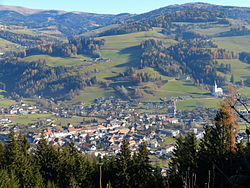Bad Sankt Leonhard im Lavanttal
| Bad Sankt Leonhard im Lavanttal | ||
|---|---|---|

View over Bad Sankt Leonhard
|
||
|
||
| Location within Austria | ||
| Coordinates: 46°58′N 14°48′E / 46.967°N 14.800°ECoordinates: 46°58′N 14°48′E / 46.967°N 14.800°E | ||
| Country | Austria | |
| State | Carinthia | |
| District | Wolfsberg | |
| Government | ||
| • Mayor | Simon Maier (SPÖ) | |
| Area | ||
| • Total | 111.72 km2 (43.14 sq mi) | |
| Elevation | 721 m (2,365 ft) | |
| Population (1 January 2016) | ||
| • Total | 4,412 | |
| • Density | 39/km2 (100/sq mi) | |
| Time zone | CET (UTC+1) | |
| • Summer (DST) | CEST (UTC+2) | |
| Postal code | 9462 | |
| Area code | 04250 | |
| Website | www.bad-st-leonhard-i-lav.at | |
Bad Sankt Leonhard im Lavanttal (Slovene: Sveti Lenart v Labotu) is a spa town in the district of Wolfsberg in the Austrian state of Carinthia.
The municipality lies in the upper Lavant valley (Lavanttal) north of the district capital Wolfsberg. The municipal area comprises the cadastral communities of Erzberg, Görlitzen, Kliening, Bad Sankt Leonhard proper, Schiefling, Schönberg, Theißing, and Twimberg.
Bad Sankt Leonhard has access to the Süd Autobahn (A2). The Lavant Viaduct across the valley was inaugurated in 1986; with a height of 165 m (541 ft), it is the second highest bridge in Austria.
The area was settled since ancient times, when a Roman road led through the Lavanttal up to the Obdach Saddle pass and the Mur valley in present-day Upper Styria. In the 11th century, the surrounding Carinthian estates were enfeoffed to the Bishops of Bamberg by Emperor Henry II.
A first chapel dedicated to Saint Leonard was consecrated during the tenure of Bishop Otto (1102–1139). His successors also had Gomarn Castle erected in order to protect their possessions, mainly from the rivalling Bishops of Lavant who resided at nearby Twimberg Castle. The settlement below the chapel was first mentioned in a 1278 deed, its citizens already had received town privileges by 1311, at the time when the Gothic parish church was erected.
...
Wikipedia


